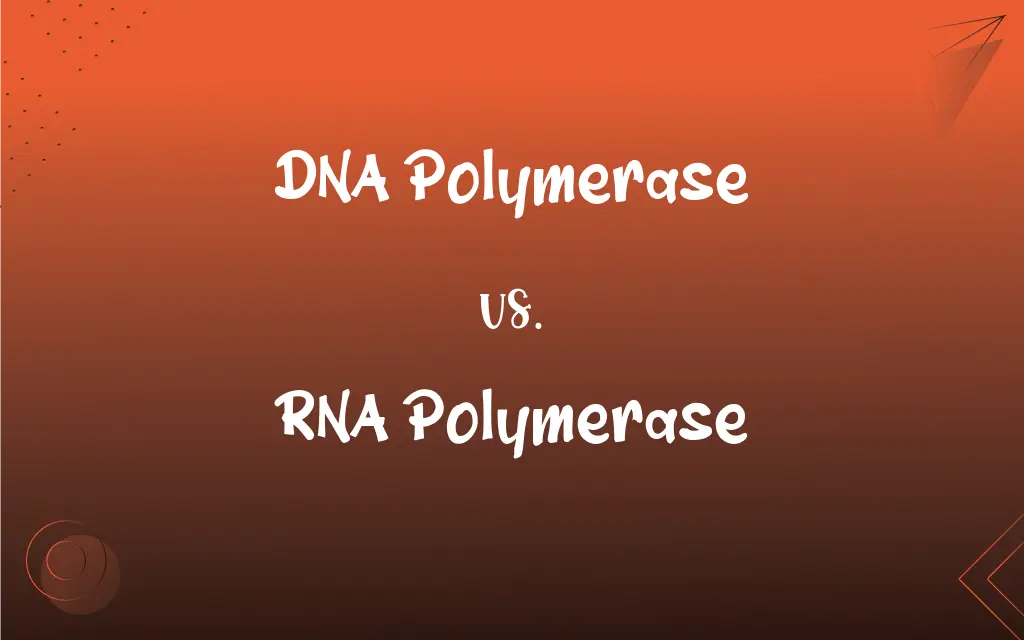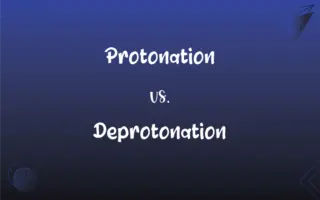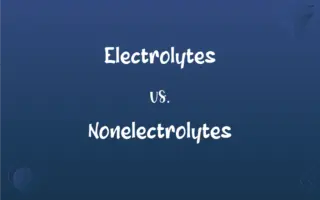DNA Polymerase vs. RNA Polymerase: What's the Difference?
Copy edited by Aimie Carlson || By Harlon Moss || Updated on October 29, 2023
DNA polymerase synthesizes DNA, while RNA polymerase synthesizes RNA. Both enzymes are crucial for cellular function and gene expression.

Key Differences
DNA polymerase is an enzyme that synthesizes DNA molecules from deoxyribonucleotides, the building blocks of DNA. RNA polymerase, on the other hand, is an enzyme that synthesizes RNA molecules from ribonucleotides using a DNA template.
DNA polymerase is essential for replicating the genetic material of the cell before cell division. RNA polymerase plays a crucial role in transcription, the first step of gene expression where a specific segment of DNA is copied into RNA.
Both DNA polymerase and RNA polymerase perform the vital function of polymerization, which is the process of linking together the nucleotide building blocks of DNA or RNA, respectively. However, DNA polymerase is involved in DNA replication, while RNA polymerase is involved in transcription.
While DNA polymerase requires a primer to initiate synthesis, RNA polymerase does not. This is one of the key differences between the two enzymes.
Another significant difference between the two is that DNA polymerase has a proofreading mechanism to correct errors made during replication, while RNA polymerase lacks this proofreading ability. This difference highlights the importance of accuracy in DNA replication to preserve the genetic information of the organism.
ADVERTISEMENT
Comparison Chart
Synthesizes DNA
Product synthesized
Synthesizes RNA
Uses a DNA template
Template used
Uses a DNA template
Essential for DNA replication
Role in cellular processes
Essential for transcription
Requires a primer
Requirement for initiation
Does not require a primer
Has proofreading mechanism
Error correction ability
Lacks proofreading mechanism
ADVERTISEMENT
DNA Polymerase and RNA Polymerase Definitions
DNA Polymerase
DNA polymerase is essential for DNA replication.
Before cell division, DNA polymerase replicates the cell's genetic material.
RNA Polymerase
RNA polymerase is an enzyme that synthesizes RNA from ribonucleotides.
RNA polymerase transcribes genes into mRNA, which is then translated into proteins.
DNA Polymerase
DNA polymerase is an enzyme that synthesizes DNA from deoxyribonucleotides.
DNA polymerase added the complementary nucleotides to the template strand during replication.
RNA Polymerase
RNA polymerase lacks a proofreading mechanism.
Errors made during transcription are not corrected by RNA polymerase.
DNA Polymerase
DNA polymerase requires a primer to initiate synthesis.
The primer provides a starting point for the DNA polymerase to begin adding nucleotides.
RNA Polymerase
RNA polymerase is essential for transcription.
Transcription is the process where a specific segment of DNA is copied into RNA.
DNA Polymerase
DNA polymerase uses a DNA template to synthesize new DNA strands.
The template strand guides the DNA polymerase to add the correct nucleotides.
RNA Polymerase
RNA polymerase uses a DNA template to synthesize RNA.
The DNA template guides the RNA polymerase to transcribe the correct sequence of RNA.
DNA Polymerase
DNA polymerase has a proofreading mechanism.
The proofreading mechanism corrects errors made during DNA replication.
RNA Polymerase
RNA polymerase does not require a primer to initiate synthesis.
RNA polymerase can start synthesis without a primer.
FAQs
What is DNA polymerase?
DNA polymerase is an enzyme that synthesizes DNA from deoxyribonucleotides.
What is RNA polymerase?
RNA polymerase is an enzyme that synthesizes RNA from ribonucleotides using a DNA template.
What is the role of RNA polymerase in the cell?
RNA polymerase is crucial for transcription, the process where a specific segment of DNA is copied into RNA.
Does DNA polymerase require a primer to initiate synthesis?
Yes, DNA polymerase requires a primer to initiate synthesis.
Are both DNA polymerase and RNA polymerase essential for cellular function?
Yes, both enzymes are crucial for gene expression and cellular function.
Can DNA polymerase function without a primer?
No, DNA polymerase requires a primer to initiate synthesis.
Are there different types of RNA polymerase?
Yes, there are different types of RNA polymerase with specific roles in transcription.
Does RNA polymerase require a primer to initiate synthesis?
No, RNA polymerase does not require a primer to initiate synthesis.
Can DNA polymerase synthesize RNA?
No, DNA polymerase can only synthesize DNA.
What is the main difference between DNA polymerase and RNA polymerase?
The main difference is that DNA polymerase synthesizes DNA, while RNA polymerase synthesizes RNA.
Can RNA polymerase synthesize DNA?
No, RNA polymerase can only synthesize RNA.
What are the building blocks used by DNA polymerase?
DNA polymerase uses deoxyribonucleotides as building blocks.
What are the building blocks used by RNA polymerase?
RNA polymerase uses ribonucleotides as building blocks.
Are there different types of DNA polymerase?
Yes, there are multiple types of DNA polymerase with different functions in the cell.
Can mutations in RNA polymerase lead to genetic disorders?
Mutations in RNA polymerase can affect transcription, potentially leading to genetic disorders.
What is the role of DNA polymerase in the cell?
DNA polymerase is essential for DNA replication, which occurs before cell division.
Does RNA polymerase have a proofreading mechanism?
No, RNA polymerase lacks a proofreading mechanism.
Can mutations in DNA polymerase lead to genetic disorders?
Yes, mutations in DNA polymerase can result in errors during replication, potentially leading to genetic disorders.
Are DNA polymerase and RNA polymerase found in all living organisms?
DNA polymerase and RNA polymerase are found in all living organisms with a cellular structure.
Does DNA polymerase have a proofreading mechanism?
Yes, DNA polymerase has a proofreading mechanism to correct errors made during replication.
About Author
Written by
Harlon MossHarlon is a seasoned quality moderator and accomplished content writer for Difference Wiki. An alumnus of the prestigious University of California, he earned his degree in Computer Science. Leveraging his academic background, Harlon brings a meticulous and informed perspective to his work, ensuring content accuracy and excellence.
Copy edited by
Aimie CarlsonAimie Carlson, holding a master's degree in English literature, is a fervent English language enthusiast. She lends her writing talents to Difference Wiki, a prominent website that specializes in comparisons, offering readers insightful analyses that both captivate and inform.































































